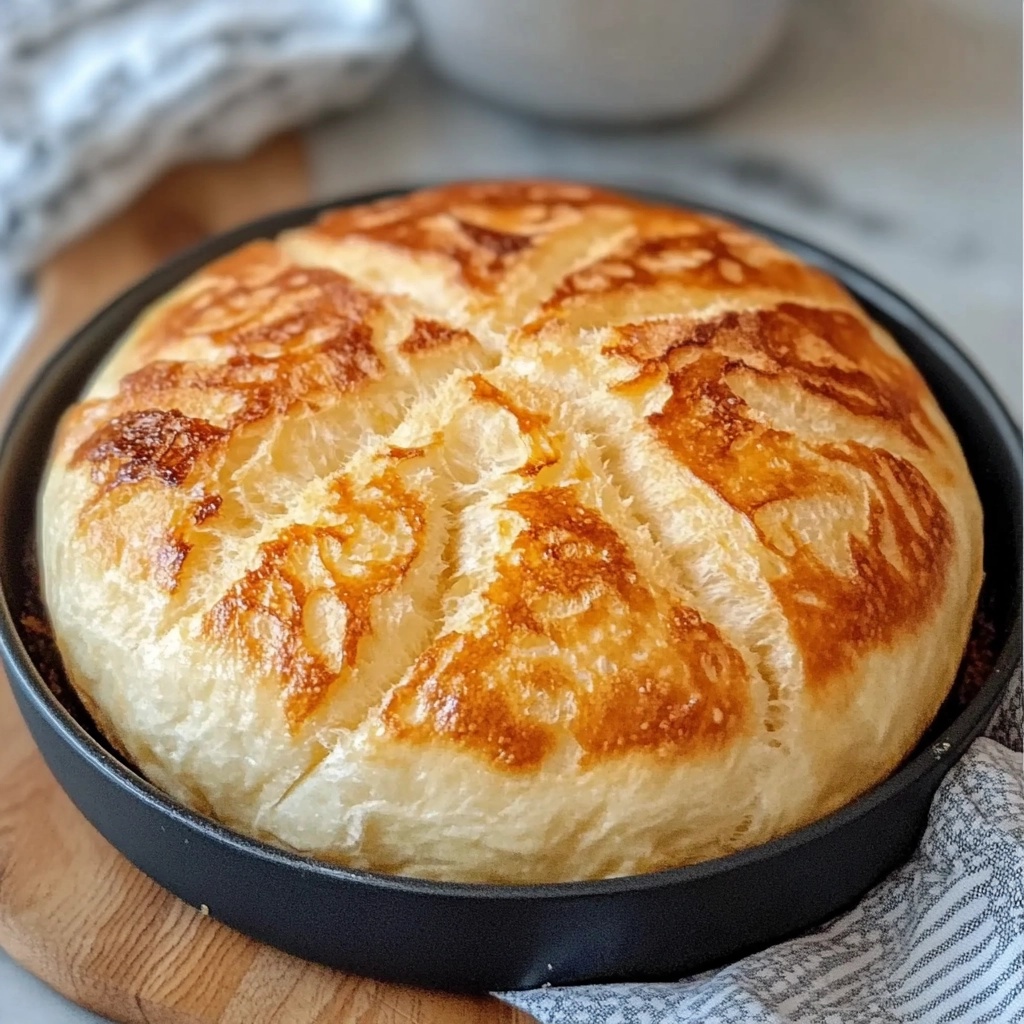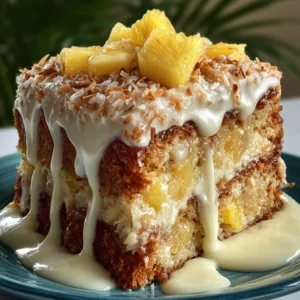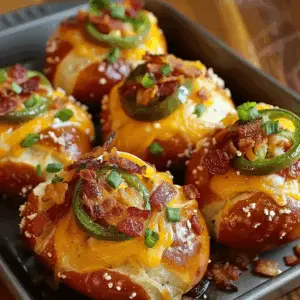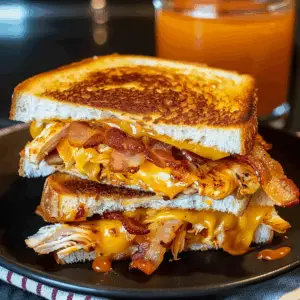Skillet bread is a versatile, easy-to-make dish that delivers both texture and flavor in every bite. Whether you’re a novice or an experienced baker, making bread in a cast-iron skillet is a straightforward process that yields delicious results. The crispy exterior combined with a soft, fluffy interior makes it the perfect side dish for any meal.
What makes skillet bread so appealing is its simplicity. You don’t need a lot of time or complicated ingredients to create this delight. The ingredients—such as all-purpose flour, baking powder, milk, butter, and eggs—are staples found in most kitchens. With just a few minutes of prep and a 25-30 minute bake, you’ll have homemade bread that pairs wonderfully with soups, stews, or even a savory dipping sauce.
This recipe uses a cast-iron skillet, an essential tool that helps distribute heat evenly and creates that signature crispness on the bottom of the bread. The butter, along with the milk and egg, keeps the bread tender and moist, making it an excellent choice for anyone looking to try something new in the kitchen.
Learn more about the benefits of using a cast-iron skillet here.
Why Skillet Bread is Perfect for Any Meal
Making skillet bread is not only about ease; it’s about creating a fluffy, golden bread with minimal effort. The texture is key—while the outside crisps up beautifully, the inside remains moist, providing the perfect balance. Whether you’re serving it as a side with a hearty stew, using it to make sandwiches, or simply enjoying it on its own, skillet bread is an ideal choice for any meal.
This bread’s versatility means you can easily adapt it to suit various flavors or diets. You can customize it with additional ingredients like herbs, cheese, or even sweet additions like cinnamon or dried fruit. You can also adjust the recipe to suit dietary needs—make it gluten-free by using gluten-free flour or dairy-free by swapping out the butter and milk with plant-based alternatives. The options are endless, making skillet bread a flexible addition to your cooking repertoire.
Additionally, making bread from scratch gives you the satisfaction of creating something fresh and delicious. The aroma of freshly baked bread filling your kitchen is a treat in itself. And since it’s so easy to make, you can enjoy this experience regularly without a lot of fuss.
For other variations, check out this Pinterest collection.
Skillet bread also makes an excellent addition to any table, especially during gatherings. Its warm, inviting appearance is sure to impress your guests, and its ease of preparation means you won’t be tied up in the kitchen for hours. In fact, you could make multiple loaves to ensure there’s enough for everyone. Serve it with a side of your favorite soup or even with a generous pat of garlic butter to complement its flavor.
For an extra twist, try adding cheese or a touch of garlic to elevate the taste. Here’s a simple recipe for garlic butter skillet bread that you can try.
Key Ingredients for Skillet Bread
Skillet bread is known for being made with simple, everyday ingredients that come together to create something truly delicious. Here’s a closer look at the essential ingredients for this recipe:
-
All-purpose flour: The base of the bread, all-purpose flour gives it the structure it needs to rise and hold its shape. While whole wheat flour is an option for those who prefer a heartier bread, all-purpose flour ensures a lighter, fluffier result. If you’re looking for a gluten-free option, you can use a gluten-free flour blend to replace the all-purpose flour.
-
Tip: Make sure to measure the flour accurately by spooning it into your measuring cup and leveling it off for the best results.
-
-
Sugar: A small amount of sugar adds just a hint of sweetness to the bread. It helps balance the savory flavors, ensuring the bread isn’t too bland. You can adjust the sugar amount if you want a sweeter bread or add a dash of cinnamon to give it a different flavor profile.
-
Salt: Salt is essential for flavor enhancement, bringing out the richness of the other ingredients. While the amount specified in the recipe works perfectly, feel free to adjust according to your taste preferences.
-
Baking powder: This is the leavening agent that helps the bread rise. The baking powder ensures that the bread has a light and airy texture, allowing it to be both crispy on the outside and soft on the inside.
-
Milk: Milk provides moisture and helps the dough come together. It also contributes to the bread’s rich texture. You can use any kind of milk—dairy or plant-based—as a substitute, such as almond milk or oat milk, for a dairy-free version.
-
Unsalted butter: Butter adds richness and flavor. The unsalted version is preferred since it gives you control over the salt content. If you prefer a dairy-free version, you can substitute with coconut oil or a vegan butter alternative.
-
Egg: The egg helps bind the ingredients together, giving the bread structure and a tender crumb. If you need an egg-free option, you can substitute with a flaxseed egg (1 tablespoon of ground flaxseed mixed with 3 tablespoons of water, let it sit for 5 minutes to thicken).
-
Olive oil: This is used for greasing the skillet, ensuring the bread doesn’t stick to the pan and helping create that crispy crust. Olive oil is the best choice here, but you can also use vegetable oil or canola oil if you prefer.
Check out more about the role of baking powder in recipes here.
Necessary Tools and Equipment
To make your perfect skillet bread, you’ll need a few essential tools and equipment:
-
Cast-iron skillet: The key to making this bread is a cast-iron skillet. It provides even heat distribution, ensuring the bread cooks uniformly and gets that perfect crisp on the outside. If you don’t have a cast-iron skillet, you can use another oven-safe pan, but cast iron really does produce the best results.
-
Oven: Preheating your oven to the correct temperature (375°F or 190°C) is crucial for getting the perfect texture on your bread. Make sure the oven is fully heated before placing the skillet inside.
-
Whisk and mixing bowls: You’ll need a whisk to combine your dry ingredients and a mixing bowl to combine your wet ingredients. A large bowl will help you mix everything together with ease.
-
Spatula or spoon: A spatula or spoon will be needed to mix your dough. The dough is thick, so a spoon works best for combining the ingredients.
Having these tools ready will ensure your bread comes out perfectly baked every time.
Learn more about the benefits of using olive oil in cooking here.
With these basic ingredients and tools, you’re set to begin making your skillet bread! The simplicity of this recipe is part of what makes it so appealing. You don’t need fancy gadgets or hard-to-find ingredients—just a few basic kitchen staples and your trusty cast-iron skillet.
Step-by-Step Preparation Process
Now that you have all the ingredients and tools ready, let’s dive into the step-by-step process of making your perfect skillet bread. This straightforward recipe comes together quickly, and soon you’ll be enjoying freshly baked bread right from your skillet.
-
Preheat the Oven
Start by preheating your oven to 375°F (190°C). This is the optimal temperature for baking the bread, ensuring it cooks through without becoming too dry or overcooked. -
Mix the Dry Ingredients
In a large bowl, whisk together the all-purpose flour, sugar, salt, and baking powder. This is your dry mixture, and it’s important to whisk well to ensure that the baking powder is evenly distributed throughout the flour. This helps your bread rise evenly when baking. -
Combine the Wet Ingredients
In a separate bowl, mix together the milk, melted butter, and the beaten egg. The melted butter should be added to the wet ingredients while it’s still slightly warm, not hot, to ensure it combines smoothly with the other ingredients. Stir until the mixture is fully blended. -
Combine Wet and Dry Ingredients
Add the wet ingredients to the dry ingredients and stir gently until they are just combined. The dough will be thick and slightly sticky—this is normal! Avoid over-mixing, as this can result in dense bread. -
Prepare the Skillet
Grease your 10-inch cast-iron skillet with about a tablespoon of olive oil. The oil not only prevents the bread from sticking but also helps it develop a crispy, golden-brown crust. You can use a paper towel to evenly distribute the oil across the bottom and sides of the skillet. -
Transfer the Dough to the Skillet
Pour the dough into the prepared skillet. Use a spoon or spatula to spread the dough evenly across the skillet. Don’t worry if it doesn’t look perfectly smooth—it will spread out during baking. -
Bake the Bread
Place the skillet in the preheated oven and bake for 25-30 minutes. The bread will turn golden brown on top, and a toothpick inserted into the center should come out clean when it’s done. If the bread is browning too quickly on top, you can cover it with a piece of foil to prevent burning. -
Cool and Serve
Once the bread is finished baking, remove it from the oven and let it cool slightly in the skillet before slicing and serving. The bread will continue to firm up as it cools, ensuring a soft interior with a perfect, crispy exterior.
For additional tips on baking bread, check out this helpful guide on Pinterest.
Preheating the Oven and Preparing the Skillet
Before you even begin mixing your ingredients, one of the most important steps is preheating your oven to the correct temperature. This ensures the bread bakes evenly and gives it the right texture. The oven should be set to 375°F (190°C), which is the optimal temperature for this recipe. If you start baking without preheating, the bread may not rise properly, leading to a dense or uneven texture.
While the oven heats up, take time to grease your cast-iron skillet with olive oil. The key here is to ensure that the oil is spread evenly on the bottom and sides of the skillet, helping to create that crispy exterior. Olive oil is preferred for this recipe because of its flavor, but you can use other oils like vegetable or canola oil if you wish.
For tips on baking with cast-iron skillets, check out this Wikipedia page on Cast Iron Skillets.
By preparing these two things first, you’re ensuring that the dough has the perfect environment to bake in, resulting in an evenly cooked, delicious loaf of skillet bread.
Baking Time and How to Check for Doneness
Now, let’s talk about how to ensure your bread is perfectly baked. The baking time for your skillet bread is 25-30 minutes. The top will become a golden brown color as it bakes, and the aroma of fresh bread will fill your kitchen. To check for doneness, insert a toothpick into the center of the bread. If it comes out clean with no wet dough sticking to it, the bread is done.
If you find that the bread is browning too quickly on top but isn’t fully baked in the center, you can cover the skillet loosely with a piece of foil. This will prevent the top from burning while the inside finishes cooking.
For more on troubleshooting baking issues, see this Wikipedia page about Baking.
Once your bread has finished baking, allow it to cool in the skillet for a few minutes before transferring it to a wire rack. This brief cooling period ensures that the bread doesn’t fall apart when sliced. Afterward, slice it up and serve warm!
With these steps in place, you’re guaranteed to end up with the perfect loaf of skillet bread, every time.
Troubleshooting Common Issues
Even though making skillet bread is a simple process, it’s always helpful to know how to troubleshoot any issues that might arise during baking. Here are some common problems and solutions to help you achieve the best results:
-
Bread is too dry: If your bread turns out too dry, it might be due to overmixing or overbaking. Avoid mixing the dough too vigorously, as this can lead to a tough texture. To prevent overbaking, always check the bread with a toothpick around the 25-minute mark. If the toothpick comes out clean, it’s done; if not, continue baking for a few more minutes.
-
Bread is too moist or undercooked in the center: If your bread remains too moist or raw in the center, this might be due to insufficient baking time or the oven not being fully preheated. Ensure that your oven is at the correct temperature before placing the skillet inside. If necessary, cover the bread with foil to allow it to cook through without further browning the top.
-
Bread is too dense: Dense bread could result from using too much flour or not using enough leavening agent like baking powder. Be sure to measure the flour correctly—scooping it directly from the container can lead to packing it too tightly. Also, don’t skip the baking powder, as it’s essential for light and fluffy bread.
-
Bread sticks to the skillet: This can be avoided by thoroughly greasing the skillet with olive oil. If you have trouble, you can also line the skillet with parchment paper before adding the dough to ensure it won’t stick.
Check out more bread-baking tips and tricks on this Pinterest page.
Flavor Variations
One of the best things about skillet bread is how easily you can customize the flavor. Here are a few variations you can try:
-
Herb and Garlic Skillet Bread: Add garlic and your favorite herbs (such as rosemary, thyme, or oregano) to the dough for an aromatic, savory loaf. This is perfect for pairing with pasta dishes or soups.
-
Cheese Skillet Bread: For a richer, more indulgent bread, add grated cheese (such as cheddar or parmesan) into the dough. You can also top the bread with cheese during the last few minutes of baking for a cheesy crust.
-
Sweet Skillet Bread: For a sweeter twist, add cinnamon, sugar, or even dried fruit such as raisins or cranberries. A sweet version of skillet bread pairs wonderfully with breakfast or as a snack.
-
Spicy Skillet Bread: Add some jalapeños or chili flakes for a spicy kick. This variation works well with savory dishes like chili or roasted meats.
Find more bread flavor ideas on Pinterest here.
Adjusting for Dietary Restrictions
If you or your guests have dietary restrictions, skillet bread can be easily adapted to meet those needs:
-
Gluten-Free Skillet Bread: Substitute the all-purpose flour with a gluten-free flour blend to make this recipe gluten-free. Be sure to check the label of the blend to ensure it contains a binder like xanthan gum or guar gum to help the bread rise.
-
Dairy-Free Skillet Bread: Replace the milk with a plant-based milk such as almond milk or oat milk, and substitute the butter with a vegan butter or coconut oil.
-
Egg-Free Skillet Bread: Use a flaxseed egg as a substitute for the egg. Mix 1 tablespoon of ground flaxseed with 3 tablespoons of water and let it sit for 5 minutes to form a gel-like consistency. This will help bind the ingredients together.
Find more information about gluten-free diets on this Wikipedia page.

FAQs
-
How do I know when my skillet bread is done?
To check for doneness, insert a toothpick into the center of the bread. If it comes out clean with no dough sticking to it, the bread is fully baked. Additionally, the top should be golden brown. -
Can I make this recipe without a cast-iron skillet?
Yes, if you don’t have a cast-iron skillet, you can use any oven-safe skillet or baking dish. A non-stick skillet works well too, though cast-iron provides the best texture and crust. -
Can I double the recipe?
Absolutely! If you want to make more, simply double the ingredients. You may need to adjust the cooking time slightly, so be sure to check for doneness by inserting a toothpick into the center. -
Can I freeze skillet bread?
Yes, you can freeze the bread after it has cooled completely. Wrap it tightly in plastic wrap or foil and store it in an airtight container. To reheat, place it in the oven at 350°F (175°C) for about 10-15 minutes.
How to Make the Perfect Skillet Bread: A Simple Recipe
This easy skillet bread is a simple, flavorful recipe that delivers a crispy outside and a soft, fluffy inside. Made with basic ingredients like all-purpose flour, butter, baking powder, and milk, this bread is a great addition to any meal. Whether served with a hearty soup or enjoyed on its own, skillet bread is quick to prepare and can be customized to fit your flavor preferences. With only 25-30 minutes of baking time, you’ll have fresh, homemade bread without the hassle.
- Author: Clara
Ingredients
- 2 ½ cups all-purpose flour
- 1 tbsp sugar
- 1 ½ tsp salt
- 2 tsp baking powder
- 1 cup milk
- ¼ cup unsalted butter, melted
- 1 egg, beaten
- 1 tbsp olive oil (for greasing the skillet)
Instructions
Preheat your oven to 375°F (190°C).
In a large bowl, whisk together the flour, sugar, salt, and baking powder.
In a separate bowl, mix together the milk, melted butter, and beaten egg until combined.
Add the wet ingredients to the dry ingredients and stir until just combined. The dough should be thick but slightly sticky.
Grease a 10-inch cast-iron skillet with olive oil and pour the dough into the skillet, spreading it evenly.
Bake in the preheated oven for 25-30 minutes, or until the top is golden brown and a toothpick inserted into the center comes out clean.
Remove from the oven and let cool slightly before slicing and serving
Notes
-
Be sure to grease the cast-iron skillet well to avoid the bread sticking.
-
For a more savory flavor, add garlic and herbs to the dough.
-
Adjust the sugar content for a sweeter bread or omit for a more neutral flavor.
-
If you’re short on time, you can substitute the milk with a plant-based alternative to make the recipe dairy-free.






